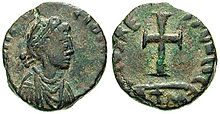The Battle of Rimini was fought in 432 between the two strong men of the Western Roman Empire, the very recently deposed Magister Utriusque Militiae Flavius Aetius and the newly appointed Magister Utriusque Militiae Bonifatius (Bonifacius or Boniface).
In 430, Aetius had the Magister Utriusque Militiae Flavius Constantius Felix executed by the army, as he was allegedly plotting against Aetius. According to Wijnendaele, Aetius was lured into confronting Bonifatius by being appointed Consul in 432, where he was deposed and Bonifatius appointed by Galla Placidia. Aetius and Bonifatius then departed the court of Ravenna, gathered their bucellarii , and met five Roman miles outside of Rimini. Aetius had brought his own troops from the West where he had intended to confront the Sueves, while Bonifatius had brought part of his troops from Africa, most likely being composed of his personal bucellarii and local Italian troops. [1] Allegedly, Aetius had a longer lance and utilized it to spear Bonifatius in personal combat during the battle. Bonifatius, though victorious, was mortally wounded during the battle and died several months later. [2] He was succeeded by his son-in-law, Sebastian, who tried to have the retired Aetius assassinated. Aetius fled to the Huns and returned possibly with a large army of Huns. Sebastian, who was unpopular with the army and the court, was exiled and Aetius quickly became the de facto manager of the Western Roman Empire. [3]

Year 432 (CDXXXII) was a leap year starting on Friday of the Julian calendar. At the time, it was known as the Year of the Consulship of Aetius and Valerius. The denomination 432 for this year has been used since the early medieval period, when the Anno Domini calendar era became the prevalent method in Europe for naming years.
The 430s decade ran from January 1, 430, to December 31, 439.

Year 430 (CDXXX) was a common year starting on Wednesday of the Julian calendar. At the time, it was known as the Year of the Consulship of Theodosius and Valentinianus. The denomination 430 for this year has been used since the early medieval period, when the Anno Domini calendar era became the prevalent method in Europe for naming years.
The 450s decade ran from January 1, 450, to December 31, 459.
The 440s decade ran from January 1, 440, to December 31, 449.
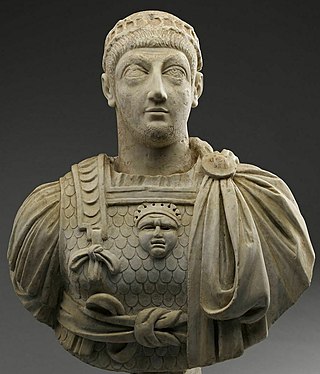
Valentinian III was Roman emperor in the West from 425 to 455. Made emperor in childhood, his reign over the Roman Empire was one of the longest, but was dominated by powerful generals vying for power amid civil wars and the invasions of Late antiquity's Migration Period, including the campaigns of Attila the Hun.

Aetius was a Roman general and statesman of the closing period of the Western Roman Empire. He was a military commander and the most influential man in the Empire for two decades (433–454). He managed policy in regard to the attacks of barbarian federates settled throughout the West. Notably, he mustered a large Roman and allied (foederati) army in the Battle of the Catalaunian Plains, ending a devastating invasion of Gaul by Attila in 451, though the Hun and his subjugated allies still managed to invade Italy the following year, an incursion best remembered for the ruthless Sack of Aquileia and the intercession of Pope Leo I.
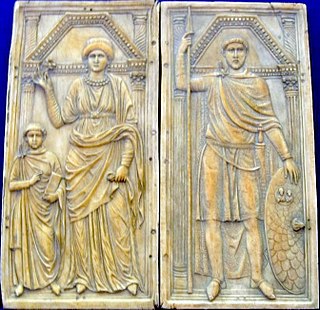
Stilicho was a military commander in the Roman army who, for a time, became the most powerful man in the Western Roman Empire. He was of Vandal origins and married to Serena, the niece of emperor Theodosius I. He became guardian for the underage Honorius. After nine years of struggle against barbarian and Roman enemies, political and military disasters finally allowed his enemies in the court of Honorius to remove him from power. His fall culminated in his arrest and execution in 408.
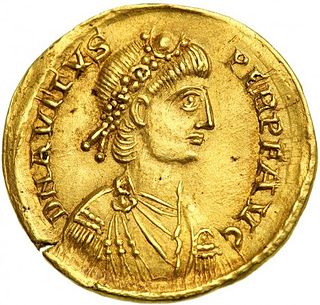
Eparchius Avitus was Roman emperor of the West from July 455 to October 456. He was a senator of Gallic extraction and a high-ranking officer both in the civil and military administration, as well as Bishop of Piacenza.
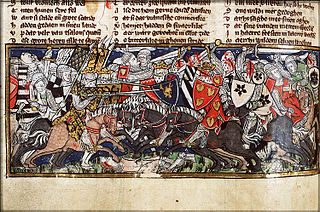
The Battle of the Catalaunian Plains, also called the Battle of the Campus Mauriacus, Battle of Châlons, Battle of Troyes or the Battle of Maurica, took place on June 20, 451 AD, between a coalition – led by the Roman general Flavius Aetius and by the Visigothic king Theodoric I – against the Huns and their vassals – commanded by their king Attila. It proved one of the last major military operations of the Western Roman Empire, although Germanic foederati composed the majority of the coalition army. Whether the battle was of strategic significance is disputed; historians generally agree that the Siege of Orleans was the decisive moment in the campaign and stopped the Huns' attempt to advance any further into Roman territory or establish vassals in Roman Gaul. However, the Huns successfully looted and pillaged much of Gaul and crippled the military capacity of the Romans and Visigoths. Attila died only two years later, in 453; after the Battle of Nedao in 454, the coalition of the Huns and the incorporated Germanic vassals gradually disintegrated.
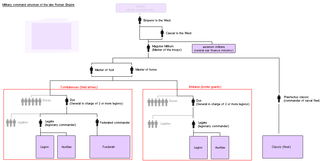
Magister militum was a top-level military command used in the later Roman Empire, dating from the reign of Constantine the Great. The term referred to the senior military officer of the empire. In Greek sources, the term is translated either as strategos or as stratelates.
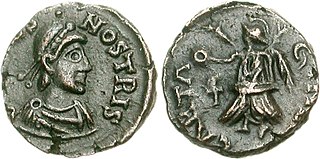
Bonifatius was a Roman general and governor of the diocese of Africa. He campaigned against the Visigoths in Gaul and the Vandals in North Africa. An ally of Galla Placidia, mother and advisor of Valentinian III, Bonifacius engaged in Roman civil wars on her behalf against the generals Felix in 427-429 and Aetius in 432. Although he defeated the latter at the Battle of Rimini, Bonifacius suffered a fatal wound and was succeeded by his son-in-law Sebastianus as patricius of the Western Roman Empire.
Bucellarii were formations of escort troops used in the Roman Empire in Late Antiquity. They were employed by high-ranking military figures or civil office-holders. Their name is derived from the type of bread rations eaten by these troops, so-called buccellatum. The term bucellarii came into common use during the reign of Emperor Honorius.
Gildo was a Roman Berber general in the province of Mauretania Caesariensis. He revolted against Honorius and the Western Roman Empire, but was defeated and possibly killed himself or was assassinated.

Marcellinus was a Roman general and patrician who ruled over the region of Dalmatia in the Western Roman Empire and held sway with the army there from 454 until his death.
Flavius Sigisvultus was a general of the late Western Roman Empire.
Sebastianus was a general of the Western Roman Empire, son-in-law of Bonifacius.

The siege of Hippo Regius was a siege from June 430 to August 431, carried out by the Vandals under their king Genseric against Roman defenders under Boniface, Count of Africa.

The Battle of Orléans took place in the year 463 pitting the forces of the Kingdom of Soissons, under the command of the magister militum Aegidius, against those of the Visigoths who were commanded by the Visigoth King Theodoric II and his brother Federico.

The Vandal conquest of Roman Africa, also known as the Vandal conquest of North Africa was the conquest of Mauretania Tingitana, Mauretania Caesariensis, and Africa Proconsolaris by the migrating Vandals and Alans. The conflict lasted 13 years with a period of four years of peace, and led to the establishment of the Vandal Kingdom in 435.
